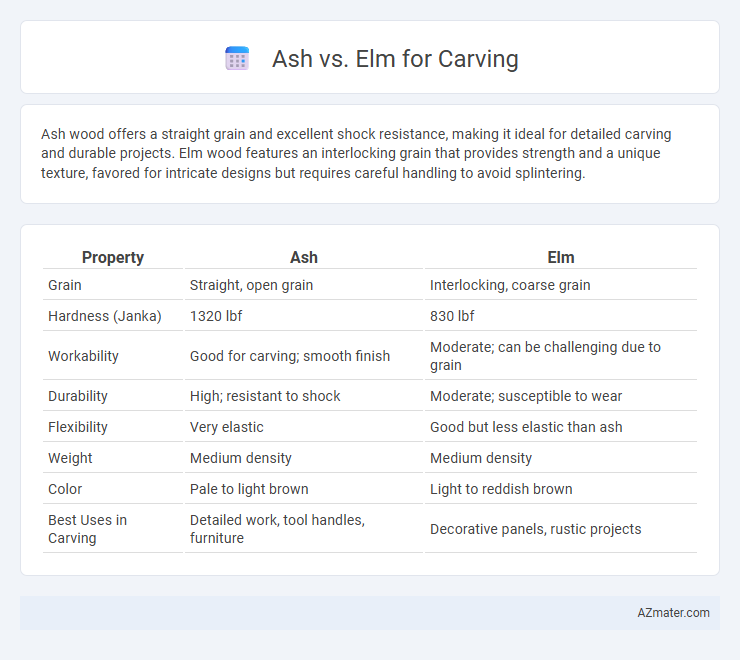Ash wood offers a straight grain and excellent shock resistance, making it ideal for detailed carving and durable projects. Elm wood features an interlocking grain that provides strength and a unique texture, favored for intricate designs but requires careful handling to avoid splintering.
Table of Comparison
| Property | Ash | Elm |
|---|---|---|
| Grain | Straight, open grain | Interlocking, coarse grain |
| Hardness (Janka) | 1320 lbf | 830 lbf |
| Workability | Good for carving; smooth finish | Moderate; can be challenging due to grain |
| Durability | High; resistant to shock | Moderate; susceptible to wear |
| Flexibility | Very elastic | Good but less elastic than ash |
| Weight | Medium density | Medium density |
| Color | Pale to light brown | Light to reddish brown |
| Best Uses in Carving | Detailed work, tool handles, furniture | Decorative panels, rustic projects |
Introduction to Ash and Elm for Carving
Ash and Elm are prized hardwoods favored by carvers for their workability and distinct grain patterns. Ash offers a straight grain with good strength and shock resistance, ideal for detailed carving and durability in tools or sculptures. Elm features interlocking grain and flexibility, allowing for smooth cuts and intricate designs while maintaining toughness for resilient carvings.
Wood Grain Characteristics: Ash vs Elm
Ash wood features a straight, uniform grain with a coarse texture, making it ideal for detailed carving and achieving smooth finishes. Elm exhibits an interlocking grain pattern with a coarse and uneven texture, offering natural strength but requiring more precise technique to avoid tear-out during carving. Both woods provide distinctive aesthetic grains, with ash delivering clean, crisp lines and elm adding rustic complexity to carved projects.
Workability and Carving Ease
Ash wood offers excellent workability with its coarse, straight grain, making it ideal for carving detailed designs without excessive wear on tools. Elm, known for its interlocked grain, can be more challenging to carve but provides a strong, durable finish that resists splitting. Both woods respond well to hand and power carving tools, but ash is generally preferred for beginners due to its easier carving properties and consistent texture.
Strength and Durability Comparison
Ash and elm are both popular hardwoods used in carving, with ash known for its exceptional strength and shock resistance, making it ideal for items that require durability and impact tolerance. Elm features interlocking grain that provides moderate strength but offers superior toughness and resistance to splitting, which is beneficial for intricate or curved designs. Overall, ash excels in applications demanding high structural integrity, while elm's durability shines in projects needing flexibility and resilience.
Texture and Finish Quality
Ash wood offers a coarse, open grain texture that allows for easier carving and achieves a rustic, natural finish favored in traditional woodworking. Elm, with its interlocked grain, presents a smoother, denser texture that provides superior detail retention and a more polished final finish. The distinct grain patterns of elm contribute to enhanced visual appeal and durability in carved pieces compared to ash.
Availability and Cost Factors
Ash wood is widely available and cost-effective, making it a popular choice for carving projects due to its abundance and moderate price point. Elm, while slightly less common, offers a unique grain pattern but tends to be more expensive and harder to source. Cost efficiency and accessibility of ash make it suitable for both beginners and professional woodcarvers seeking reliable material options.
Best Carving Applications for Ash
Ash wood is highly favored for carving due to its excellent strength-to-weight ratio and open grain, making it ideal for detailed woodwork and sculptures. Its durability and flexibility allow artisans to create intricate designs in applications such as furniture accents, tool handles, and sporting goods, where resilience and shock absorption are critical. Compared to elm, ash offers more uniform carving properties, making it the best choice for projects requiring both aesthetic appeal and structural integrity.
Best Carving Applications for Elm
Elm wood excels in carving applications requiring intricate detail and durability due to its interlocking grain and resistance to splitting. It is ideal for creating furniture elements, sculpture bases, and tool handles where strength and shock resistance are essential. Compared to ash, elm offers superior flexibility in curved carving projects, making it a preferred choice for artisans needing precise control and long-lasting results.
Carving Tools and Techniques for Each Wood
Ash and elm respond differently to carving tools due to their distinct grain structures. Ash, with its straight grain and coarse texture, is best carved using gouges and chisels with sharp, durable blades to achieve smooth, clean cuts. Elm, featuring interlocking grain, requires tools with finely honed edges and careful technique to prevent tear-out, making knives and V-tools ideal for detailed work.
Final Verdict: Choosing Between Ash and Elm
Ash offers superior strength and shock resistance, making it ideal for detailed and durable carving projects. Elm features interlocking grain that resists splitting, providing a unique texture suited for rustic or natural-looking carvings. Choose ash for precision and longevity, while elm is best for organic, textured designs where resilience to cracking is essential.

Infographic: Ash vs Elm for Carving
 azmater.com
azmater.com